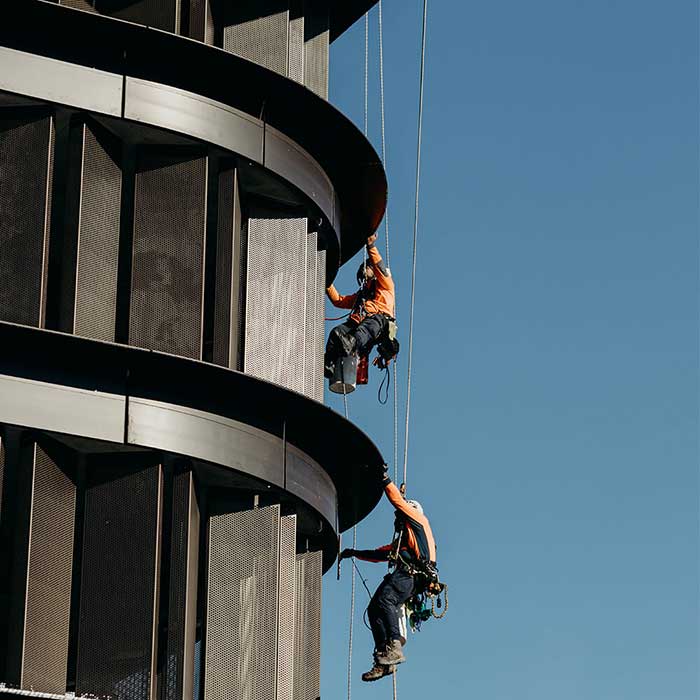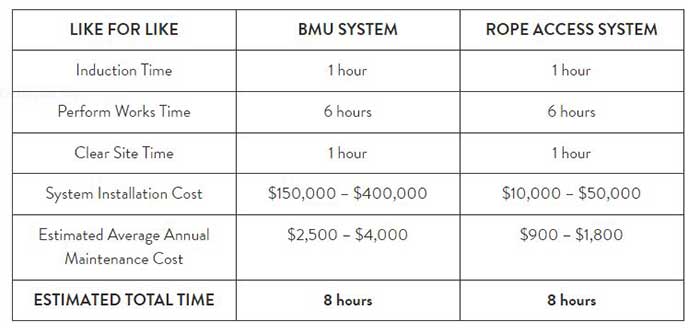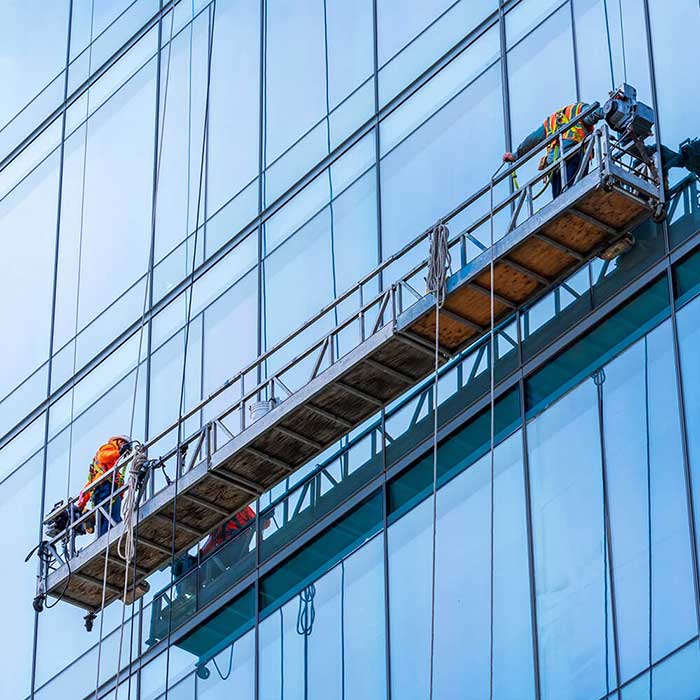Rope access systems and building maintenance units (BMUs) are the two options often preferred by builders, building owners and architects when designing a facade access solution.
While both systems have their advantages and disadvantages, the choice of system typically depends on the site where it will be installed, with multiple factors such as budget, maintenance requirements, roof space, and facade structure given due consideration.
Cost
Cost is the primary consideration in the comparison between BMUs and rope access systems – BMUs are expensive to install and maintain, and have high sub-structural load requirements.
Over a 10-year period, maintaining a rope access system will cost just a fraction of what it would take to maintain a BMU system. However, when the building has a large, complex facade, and the BMU system is used regularly, the advantages of a BMU may outweigh the cost-savings of a rope access system in certain situations.

Rope access systems offer a more cost-effective and flexible option for small to medium buildings with simple facades.
A BMU will cost $150,000 to $400,000 to install, compared to $10,000 to $50,000 for a rope access system. The estimated annual maintenance cost for a BMU is also significantly higher, ranging from $2,500 to $4,000 compared to $900 to $1,800 for a rope access system. With a much lower initial outlay and ongoing maintenance costs, a rope access system will deliver significant cost savings over a BMU.

Time
A BMU takes longer to install than a rope access system. However, operationally, both systems have similar timelines, with a 1-hour induction time, 6 hours to perform the work, and 1 hour to clear the site over an 8-hour day.
BMUs Pros & Cons

Pros
- Accessibility: Provides safe and easy access to all parts of the building, including hard-to-reach areas.
- Efficiency: Maintenance work can be done quickly and efficiently, minimising disruptions to occupants.
- Safety: Provides a secure platform for workers with low training, protecting them from falls and other accidents.
- Flexibility: Can be customised to suit the needs of most buildings.
- Glass replacement: Good glass replacement capabilities except in under-hang sections of the building.
Cons
- Cost: Expensive to install and operate; high maintenance costs; 4 compliance visits and one full service required annually.
- Space: Occupies a large amount of space on the roof of the building and has a high sub-structural load requirement.
- Reliability: Higher risk of breakdown due to complex machinery.
- Retrofit: Difficult to add to existing buildings or structures.
- Visibility: Can be unsightly, impacting building aesthetics.
- Weather: Only suitable for use in good weather conditions.
Rope Access Pros & Cons
Pros
- Accessibility: Can access areas that are difficult or impossible to reach with a BMU.
- Efficiency: Can be set up quickly and easily, reducing downtime for the building and has the ability to have multiple workers on the site at the same time.
- Cost: Less expensive to install and maintain; low inspection costs; one compliance testing visit required annually.
- Flexibility: Can be used on a wide range of building types and sizes, and customisable to suit the needs of most buildings.
- Safety: Properly trained rope access technicians can work in a safe and controlled manner.
- Visibility: Has a more discreet presence compared to BMUs.
- Weather: Can be used in a wider range of weather conditions.
- Glass replacement: Good glass replacement capabilities especially on under-hang sections but has load limitations.
Cons
- Space: The working area can sometimes be more limited but is remedied by increasing the number of technicians working at any one time. Can be difficult to access some complex facades.
- Efficiency: Less capacity for heavy tools and equipment. Limitations for glass replacement on some high-rise buildings but still possible, although it requires a specialised team.
Conclusion
High-rise buildings with complex facades should ideally go for a combination of BMU and rope access systems. With their unique advantages, the two systems will allow for a more efficient and cost-effective solution for building access and maintenance.
Choosing between a BMU and a rope access system will depend on several factors, including the type of building, the nature of the maintenance work, and budget.
The multi-award-winning Quay Quarter Tower project in Sydney CBD is an excellent example of a successful collaboration between the developer Multiplex, the BMU company FARRA Engineering, as well as SAYFA Group, the design consultants and manufacturers of difficult access systems, to identify, troubleshoot, and execute the complex facade access requirements of the building.
The primary objective of the project was to ensure that the two different access systems could work seamlessly without interfering with each other’s parameters. The successful execution of this project highlights the importance of collaboration in achieving complex construction objectives, and serves as an inspiration for similar projects in the future.

